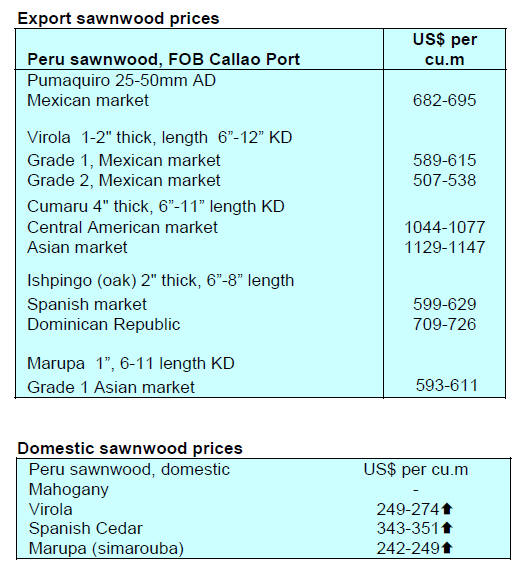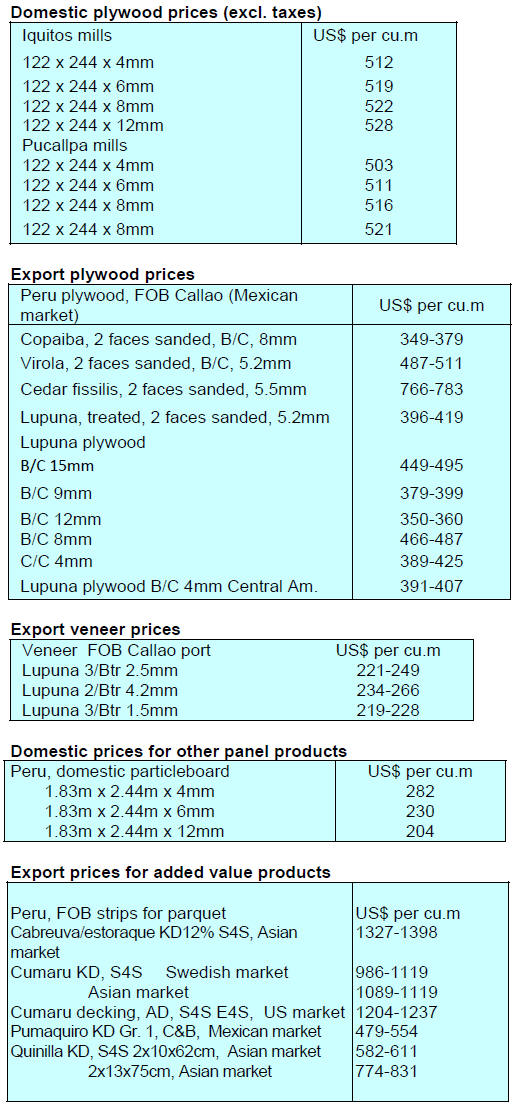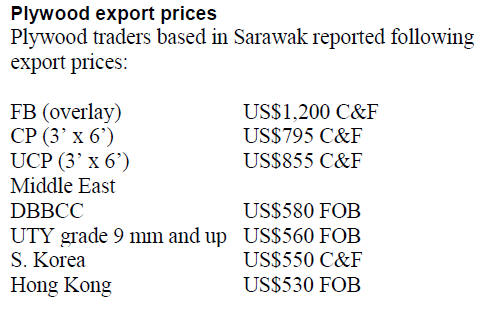
4.
INDONESIA
Disrupted global economies but wood
product exports
still positive
Despite the current global issues due to the prolonged
Covid-19 pandemic and the continued aggression by
Russia in Ukraine, wood product exports are encouraging.
As of June wood product exports totalled US$7.06 billion,
an increase of 11% year on year.
The performance up to June was driven by exports of three
products, paper, woodbased panels and pulp.
The value of paper product exports was US$2.05 billion
(up 6.4% YoY), woodbased panels at US$1.66 billion (up
27% YoY) and pulp at US$1.56 billion. The other product
recording growth was prefabricated buildings. The slowest
growth was recorded for joinery products.
The upstream sector also experienced a positive trend.
Production of logs from natural forests, plantation forests
and Perhutani managed areas increased slightly. Until June
log production from natural forests was 2.30 million
cu.m,, an increase of 0.2% year on year. Log production
from plantation forests was 22.44 million cu.m,, up 2.2%.
See:
https://forestinsights.id/2022/07/16/ekonomi-globalbergejolak-ekspor-produk-kayu-indonesia-masih-catat-trenpositif/
Breakthrough in exports of Lightwood products
The Minister of Trade, Zulkifli Hasan, said he applauds
the efforts being made by the Indonesian Light Wood
Association (ILWA) to improve exports through
collaboration with a light wood processing company in
Austria.
ILWA will work to increase the added value of light wood
products through capacity expansion, product
adaptation/innovation and technology utilisation.
In 2021 Indonesia's exports of light wood products
(plywood and flooring) totalled US$3.2 billion or 45% of
Indonesia's total exports of wood products. Indonesia's
wood product exports in 2021 reached US$7.94 billion, an
increase of 31% compared to the previous year.
See:
https://wartaekonomi.co.id/read431253/tingkatkan-kinerjaekspor-produk-kayu-ringan-mendag-zulkifli-hasan-dukungterobosan-ilwa
'Redefine, Inspire, Innovation' theme for IFEX 2022
The Indonesian Furniture and Handicraft Industry
Association (HIMKI) and Dyandra Promosindo, a leading
professional exhibition organiser, are preparing to stage
Indonesia's largest B2B furniture and craft exhibition,
‘Indonesia International Furniture Expo’ (IFEX) 2022 on
18-21 August. Abdul Sobur, chairman of HIMKI, said
more than 200 exhibitors (more than 95% of the target
exhibitors) will participate in this year's show. The theme
for the exhibition is 'Redefine, Inspire, Innovation' and the
aim is to redefine the concept of furniture and handicraft
products for the international market, inspire local
products to compete in the global market and present the
latest innovations in furniture and handicraft products.
Indonesian exports of furniture and handicrafts in 2021
were recorded at US$3.46 bil. Up 27% year on year.
See:
https://www.furniturenews.net/events/articles/2022/08/18/32278579-indonesian-exhibition-set-galvanise-local-industry
and
https://ifexindonesia.com/
‘NeXT Forest’ a technology for peat-forest
management
Sumitomo Forestry Co., Ltd. and the IHI Corporation have
joined forces to introduce satellite technology via ‘NeXT
Forest’ a project that can guide companies holding Forest
Utilisation Permits (PBPH) and oil palm plantations to
address the challenges of managing peatlands and tropical
forests. The Director General of Sustainable Forest
Management at the Ministry of Environment and Forestry
(KLHK), Agus Justianto, indicated that he hopes NeXT
Forest can support Indonesia's FOLU Net Sink 2030.
‘NeXT Forest’ combines Sumitomo’s Forestry experience
and knowledge of best practices in peat management with
satellite technology and weather monitoring system
developed by a leading Japanese company, IHI
Corporation. NeXT Forest is a tool for oil palm plantation
and peatland forest managers and is able to monitor the
health of the forest and will support the development of
Indonesia’s carbon credit market.
See:
https://agroindonesia.co.id/sumitomo-forestry-ihicorporation-perkenalkan-next-forest-tawarkan-solusipengelolaan-hutan-gambut-berkelanjutan/
and
https://www.ihi.co.jp/csr/english/nextforest/
Young forest rangers have crucial role in forestry
sector: ministry
Bambang Hendroyono, ,Secretary General of the Ministry
of Environment and Forestry said young forest rangers
who contribute to the management of forests have an
important role in the forestry sector. He encouraged young
foresters to become initiators, actors, motivators, catalysts
and even educators in promoting forestry development. In
this quickly changing world imaginative leadership is
needed in all sectors and levels of organisations including
the forestry sector, he said.
See:
https://en.antaranews.com/news/239945/young-forestrangers-have-crucial-role-in-forestry-sector-ministry
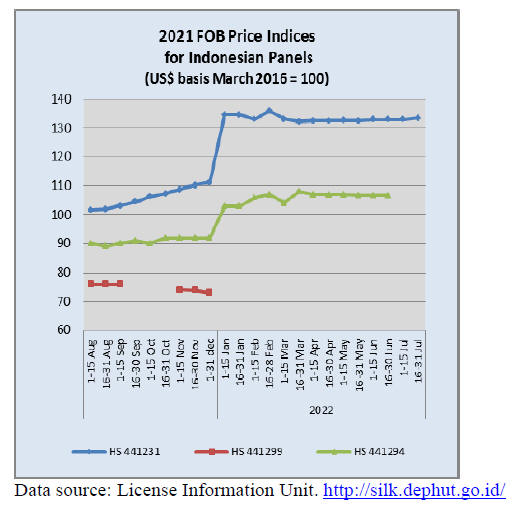
5.
MYANMAR
Timber drops from list of major
exports
Exports of agricultural products earned US$4,624 million
in fiscal 2020-2021. The main products were rice, broken
rice, beans and pulses. Despite of the depreciation of
MMK, exporters did not enjoy a rise in income as earnings
had to be exchanged for local currency at the fixed rate of
1850 MMK. In the unofficial market the dollar earns
MMK2,500 MMK.
Timber exports were previously among the top three
export products since 2000 but the ranking declined from
2014 when the log export ban was introduced. Before
2014 timber exports were worth over US$500 million
annually.
Ways to increase foreign reserve holdings
It has been confirmed that the Central Bank ordered the
Myanma Timber Enterprise (MTE) to conduct its sales in
local currency (MMK) and also to accept the MMK at a
fixed exchange rate of MMK1,850 per dollar for logs sold
prior the new regulation. Timber exporters are less
impacted compared to importers in other sectors relying
on imported raw materials, prices of which increased by
40 to 60%.
It is also learnt that the Forest Joint Venture Corporation,
an economic institution with a large the government
shareholding, has been required to convert its US$
holdings to MMK. According to information from the last
General Assembly, FJVC had around US$16-18 million in
cash deposits. This new exchange regulation resulted in
the FJVC to lose about MMK10 billion because of the
government fixed exchange rate.
Currency chaos continues
In a recent press conference a Deputy Minister in the
government stated that the government has considerable
foreign reserve and there is no possibility of state
bankruptcy like Sri Lanka. Despite of these assurances
demand for the US dollar is growing as a result of
the alarming rate of depreciation rate of MMK.
Recently, the Ministry of Trade said that import license
will only be issued if the importer buy dollars from the
bank. The result of this is that prices have shot up. For
example prices for medicines have increased at 25 to
50% and many essential drugs are no longer avaialble.
In a recent move, the Central Bank has ordered companies
and individual borrowers to suspend repayment of foreign
loans as foreign reserves fall. In a related development, the
Central Bank ordered companies with up to 35% foreign
ownership to convert foreign exchange holdings into the
local currency.
Myanmar GDP at bottom of ASEAN
Singapore is ASEAN’s richest country with a GDP per
capita of US$65,233 while Myanmar is at the bottom in
ASEAN. Brunei and Malaysia are the second and the
third-richest countries with per capita GDP of US$31,087
and US$11,414.
By contrast, Myanmar is among the poorest country in the
region, with a GDP per capita of US$1,408. East Timor
and Cambodia also have a GDP per capita of less than
US$2,000.
6.
INDIA
More trade with Russia
The Reserve Bank of India (RBI) has endorsed use of the
rupee for international settlements which will likely
increase Russia-Indian trade. Indian imports from Russia
jumped 272% in the April-May period this year as Russian
companies search for alternative markets.
The Russian oil and gas sectors have been the main
exporters to India but it is reported the two countries are
seeking ways to diversify trade beyond the traditional
areas. India is looking at expanding into new areas such as
coking coal, timber, LNG and agricultural products.
See:
https://www.russia-briefing.com/news/why-russianexporters-should-be-looking-to-the-india-consumer-market-fordiversifying-trade.html/
Rising interest rates dampen consumer sentiment
There were signs in June that economic activity was
slowing as price increases, rising interest rates and a
weakening rupee dampened consumer sentiment. Pent-up
demand drove an economic revival but now rising prices
are biting. The RBI raised rates recently to slow price
growth and is likely to raise rates when it meets again.
See:
https://economictimes.indiatimes.com/news/economy/indicators/indias-economic-recovery-falters-as-high-prices-start-tobite/articleshow/93015250.cms?utm_source=contentofinterest&utm_medium=text&utm_campaign=cppst
In mid July the rupee fell to an all-time low of
80.05 against the US dollar. This has pushed up import
costs which are hard to pass on currently.
See:
https://www.outlookindia.com/business/rupee-below-80-atwhat-level-will-it-become-unsustainable-for-indian-economy--news-209585
Declining investment in real estate
As prospects for continued growth in the short term have
weaked institutional investments in the Indian real estate
sector has fallen. In the second quarter of this year there
was a 27% year on year drop in total investments. In the
office segment there was an increase in investment but it
was the lower investment in the housing segment that
pulled down the overall figure.
See:
https://www.jll.co.in/en/trends-and-insights/research/pulsereal-estate-monthly-monitor-may-2022
Plywood market sluggish
The slowing of economic growth has impacted sales of
wood products and the plywood sector has been affected.
Weak sentiment, a reaction to steep inflation, rising costs
and labour shortages are major issues. Recent efforts to
raise plywood prices have met with little success
especially by small producers which need to sustain sales
in a down market.
A PlyReporter “Market Sentiment Survey” found that
major plywood sales in the tier three cities have been
performing well for plywood and laminates thanks to
various projects and steady demand for
furniture. PlyReporter foresees a pickup in sales during
June-July and that the resumption of work-in-office will
help drive sales.
See:
https://www.plyreporter.com/article/93087/plywooddemand-remain-to-be-sluggish
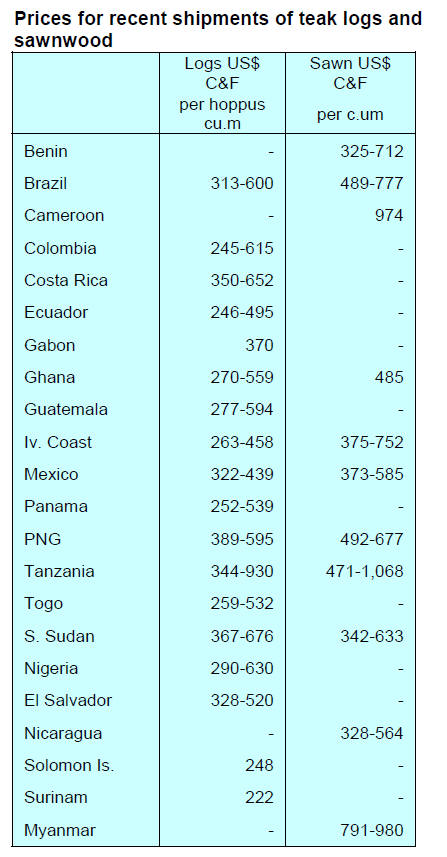
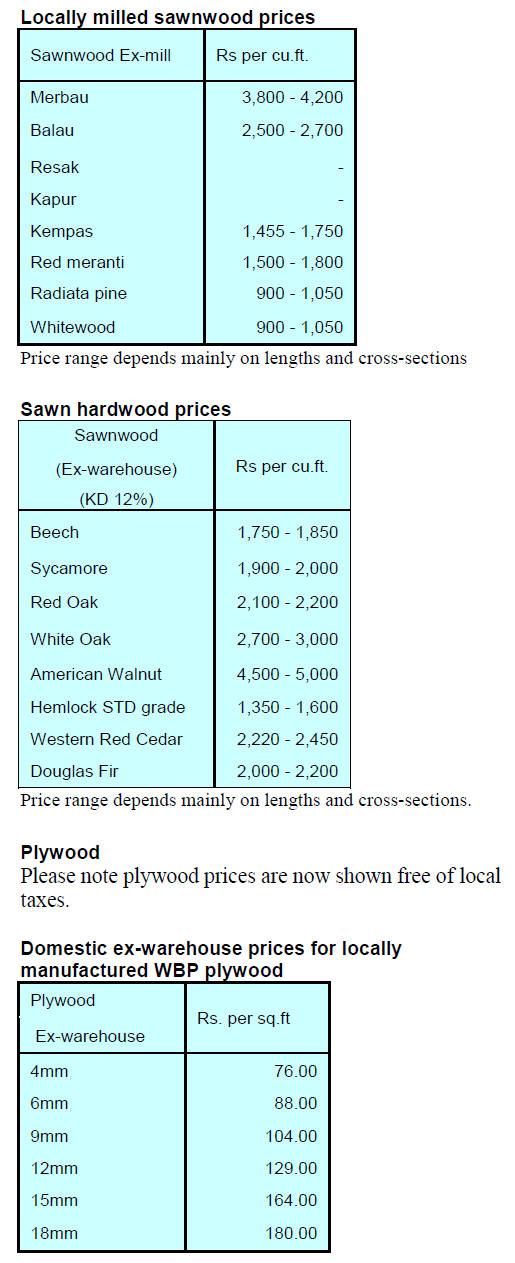
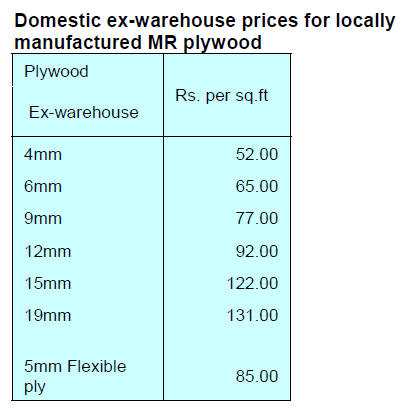
7.
VIETNAM
Wood and wood product (W&WP) trade highlights
Export earnings from W&WPs in June 2022 reached
US$1.4 billion, down 10.9% compared to June 2021. Of
this WP exports reached US$ 936.5 million, down 25%
compared to June 2021. For the first 6 months of 2022
W&WP exports reached US$8.4 billion, up 1.7% over the
same period in 2021.
The W&WP exports to Japan in June 2022 reached
US$166 million, up 3% compared to June 2021. In the
first half of 2022 W&WP exports to Japan reached
US$844.3 million. a rise of almost 20% over the same
period in 2021.
In June 2022 exports of wooden bedroom furniture earned
US$205.2 million, down 12% compared to June 2021. In
the first 6 months of 2022 earnings from the export of
wooden bedroom furniture reached US$1.28 billion, up
3.4% over the same period in 2021.
W&WP imports in June 2022 reached US$303 million,
down 5.4% compared to May 2022 but compared to June
2021 it increased by 13%. In the first 6 months of 2022
imports reached US$1,577 billion, up 2.0% over the same
period in 2021.
Vietnam's imports of ash wood in June 2022 are estimated
at 36,700 cu.m, worth US$8.8 million, down 2% in
volume and 5.4% in value compared to May 2022.
Compared to June 2021 imports were up 7.4% in volume
and 8.8% in value.
Imports of logs and sawnwood from the US in May 2022
reached 56,310 cu.m, worth US$28.54 million, up 33.8%
in volume and 35.6% in value compared to April 2022 but
down 2.3% in volume, but up 11.0% in value compared to
May 2021.
In general, in the first 5 months of 2022 imports of logs
and sawnwood from the US reached 211,285 cu.m, worth
US$102.01 million, down 33.9% in volume and 21% in
value over the same period in 2021.
W&WP exports to Japan surging
W&WP exports to Japan in June 2022 reached US$166
million, up 34.9% compared to June 2021. In the first half
of 2022 exports to Japan totalled at US$844.3 million, up
20% over the same period in 2021.
Exports of woodchips, wood-based panels, flooring,
wooden doors and handicrafts increased sharply in May
2022 leading to a significant increase exports to Japan.
Wooden furniture was the second largest export group
to Japan in the first 5 months of 2022 and were worth US$
226.8 million, up 1.3% over the same period last year.
Demand for wooden furniture in Japan has always been
high. In the global market Japan is the 5th largest import
market after the US, EU, UK and Canada. Japan's import
of wooden furniture in the first 5 months of 2022, reached
330,000 tonnes worth 23.2 billion yen , down 8% in
volume but up 11% in value over the same period in
2021.
Japan imported the largest volume of wooden furniture
from China reaching 150,100 tonnes worth 58.7 billion
yen, down 8.5% in volume and 10.5% in value over the
same period in 2021.
This was followed by imports from Vietnam reaching
84,400 tonnes, worth 29.7 billion yen, down 7.9% in
volume but up 13.4% in value over the same period in
2021.
Amongst the range of wooden furniture exported from
Vietnam to Japan in the first 5 months of 2022 livingroom
and dining-room furniture accounted for 21% ,
bedroom furniture (34%), wooden seats (25%), kitchen
furniture (49%) and the balance was mainly office
furniture.
Vietnamese manufacturers exporting to Japan enjoy the
advantage of tax reductions under the free trade
agreements to which Vietnam and Japan are signatories,
such as Vietnam - Japan Economic Partnership Agreement
(VJEPA), ASEAN - Japan Comprehensive Economic
Partnership (AJCEP), Comprehensive and Progressive
Agreement for Trans-Pacific Partnership (CPTPP),
Regional Comprehensive Economic Partnership
Agreement (RCEP).
Ash wood imports in the first 6 months of 2022
In the first 6 months of 2022, ash wood imports amounted
to 195,400 cu.m, worth US$45.9 million, down 21.6% in
volume and 22.2% in value year on year.
Imports of ash from the EU were the largest reaching
152,200 cu.m, worth US$34.5 million down 21.5% in
volume and 23.8% in value over the same period in 2021.
Imports from Belgium decreased by 29%; France down
by 7%; the Netherlands dropped by 18%; Denmark fell by
22%; Croatia minus 9% against the same period in 2021.
Ash imported from the US accounted for 1.4% of total
imports, reaching 2,300 cu.m, worth US$1.5 million,
down 72% in volume and 51% in value over the same
period in 2021. The average import price of ash logs in the
first 5 months of 2022 was US$ 234/cu.m, down 1.3%
over the same period in 2021.
Wood imports from the US regaining growth
Following many months of decline Vietnam’s imports of
logs and sawnwood from the US have increased. Imports
of log and sawnwood from the US in June 2022 increased
for the 4th consecutive month reaching 78,000 cu.m.
In the first 6 months of 2022 imports of logs and
sawnwood from the US were estimated at 289,285 cu.m,
with the value of US140.01 million, down 23% in volume
and 9% in value over the same period in 2021.
To assure the legality of exported wood products in line
with VPA/FLEGT requirements Vietnam needs a large
quantity of wood imported from low-risk sources such as
the US. To satisfy the demands of certain groups of US
customers Vietnamese furniture manufacturers have been
using American wood to produce furniture for export to
the US market. With the lower price of sawnwood sourced
in the US imports of log and sawnwood from the US are
expected to rise further.
In the first 5 months of 2022, the average price of
imported sawnwood from the US was US$645/cu.m, up
by 48% over the same period in 2021.
Doubts raised on timber company growth prospects
Wood products sales are rising bringing some relief to
manufacturers. However, skyrocketing prices of raw
materials and logistic costs will weigh on profits this year.
VNDIRECT Securities Corporation estimated that the
total revenue of listed wood and wood products companies
in the first quarter (Q1) of 2022 rose by 10.2% year-onyear
thanks to the recovery of wood product
manufacturers in the south.
After the social distancing order was lifted most wood
product manufacturers in the southern region resumed
operations at 90% capacity in the first quarter of 2022, in
the second half of 2021 it was only 60-65%.
The Market research and consulting firm Grand View
Research forecast that the US wooden furniture market
value would grow by around 7.9% over the five years
from 2022 to 2027 driven by significant growth in singlefamily
houses, while home loans in the US are at the
highest level since 2018, with home loan contracts up 8%
over last year in April.
Analysts expected that high demand for housing in the US
would boost the purchase of wooden furniture products
and that Vietnam’s timber industry could benefit from
China's reduction in production capacity.
Despite countries around the world easing COVID
measures, China continued to pursue the zero COVID
policy with prolonged lockdowns in many areas such as
Jiangsu, Jilin, Guangdong and Shanghai. It has been
reported that three of the ten largest wood manufacturers
in China have had to close factories in Shanghai and
Jiangsu due to the impact of COVID-19.
The securities firm forecast that the real estate market
would witness a recovery in the supply side in 2022 as
developers would focus on boosting sales to improve cash
flow. This was reflected in the prospects of strong growth
in sales of listed real estate companies this year.
VNDIRECT believes that the profit margins of wood and
furniture companies in 2022 would be affected as the
supply shortage would continue to push up the price of
wood materials. This year the gross profit margin of wood
and furniture companies would continue to fall 0.4-0.6
percentage points, VNDIRECT said.
Container shipping costs have increased from US$1,00 per
40ft container (Shanghai-Los Angeles route) in July 2019
to nearly US$8,850 per 40ft container in March, six times
higher over five years.
Although transportation costs have shown signs of cooling
in April, down 10% from the previous month, the
securities company still expected that logistics costs would
remain at a high level.
See:
https://en.vietnamplus.vn/rising-costs-cast-doubt-on-woodcompanies-growth-prospects/231868.vnp
Investigation into Vietnam's export of wooden cabinets
The Vietnam Timber and Forest Products Association
said the US Department of Commerce (DoC) had notified
Vietnamese authorities of an application to investigate
suspicions of trade remedy tax evasion on wooden
cabinets imported from Vietnam and Malaysia.
The products proposed for investigation is wooden
cabinets with HS codes 9403.40.9060, 9403.60.8081 and
8403.90.7080. The plaintiff is the American Kitchen
Cabinet Alliance representing a number of US wood
cabinet manufacturers.
According to the Association the US issued an order to
impose anti-dumping and anti-subsidy taxes on the same
products originating from China in February 2020. Since
then exports of these products from China to the US have
plummeted by 54%. Regarding other imported timber
products from Vietnam, the DoC announced an extension
of the time to issue the final conclusion on the antidumping
and anti-subsidy tax evasion investigation
case with hardwood plywood from Vietnam.
The DoC is expected to issue its final conclusion on
October 17, 2022, instead of April 20, 2022, as previously
announced. This is the DoC's third renewal of this content.
See:
https://vietnamnews.vn/economy/1190387/us-initiates-aninvestigation-into-viet-nam-s-export-of-wooden-cabinets.html
8. BRAZIL
Proposals for forest preservation in
the Northern
Region
An expert group for the Amazonia Que Eu Quero (The
Amazon I Want) released ten suggestions to address the
problems debated in the ‘Forests’ forum according to the
Amazon Network Foundation (FRAM).
The proposals will be included in an agenda with all the
others from the five forums; Infrastructure, Clean Energy,
Economic Model in the Amazon, Entrepreneurship and
Forests, which will be delivered in September 2022 to the
Brazilian Congress.
The proposals on forests include the need to value the
cultural and economic practices in forest use, strengthen
governance, provide resources for R&D, encourage startups
and company investment, correctly value standing
forests, improve production chains and foster public
policies for the sustainable multiple use of forest
resources.
The objective of the ‘'Amazônia Que Eu Quero’' initiative
is to expand the capacity for analysis of the population of
the Northern region by gathering information on public
management. The project is developed in the states of
Amazonas, Acre, Amapá, Rondônia and Roraima.
See:
https://g1.globo.com/am/amazonas/noticia/2022/07/19/amazoniaque-eu-quero-divulga-10-propostas-de-preservacao-de-florestasda-regiao-norte.ghtml
National leader in wooden furniture exports
The State leader for exports of wooden furniture, the Santa
Catarina furniture industry, achieved earnings of
US$166.3 million in exports in the first half of 2022, an
almost 5% increase in comparison with the same period in
2021.
The United States was the main destination for Santa
Catarina furniture exports with a 58% share followed by
the United Kingdom with 9% and France with a 6%.
Among the Santa Catarina products sold abroad, the
highlight is the wooden furniture. Manufacturers in the
State have a competitive furniture industry. The sector has
great opportunities to advance in the domestic and
international markets by adding value to its products
according to the Industry Federation of Santa Catarina
(FIESC).
Industrial production of wood products increased almost
5% May 2022 compared to April 2022, this was higher
than the national average of 3.2% according to FIESC.
The pace of growth also genered new formal jobs.
Between January to May this year the timber and furniture
sectors generated 2,800 new jobs.
See:
https://visornoticias.com.br/santa-catarina-ja-exportou-maisde-r900-milhoes-em-moveis-de-madeira-em-2022/
Export update
In June 2022 Brazilian exports of wood-based products
(except pulp and paper) increased 222% in value
compared to June 2021, from US$395.8 million to
US$483.5 million.
Pine sawnwood exports grew 14% in value between June
2021 (US$66.6 million) and June 2022 (US$75.8 million).
In terms of volume, exports declined 5% over the same
period, from 278,700 cu.m to 264,700 cu.m.
Tropical sawnwood exports increased significantly rising
41% in volume, from 40,000 cu.m in June 2021 to 56,300
cu.m in June 2022. In terms of value, exports grew 91%
from US$14.1 million to US$26.9 million over the same
period.
Pine plywood exports faced a 29.9% decrease in value in
June 2022 compared to June 2021, from US$138.4 million
to US$97.0 million. In volume, exports also decreased
7.5% over the same period, from 239,800 cu.m to 221,800
cu.m.
As for tropical plywood, exports increased in volume
(3.8%) and in value (25.0%), from 5,300 cu.m (US$2.8
million) in June 2021 to 5,500 cu.m (US$3.5 million) in
June 2022.
As for wooden furniture export earnings dropped from
US$62.5 million in June 2021 to US$59.3 million in June
2022, a 5% decline.
Participation in Argentine furniture fair
In order to foster trade partnerships with Argentina the
‘Orchestra Brazil’ project managed by the Furniture
Industry Union of Bento Gonçalves (Sindmóveis) with
support from the Brazilian Agency for Export Promotion
and Investment (ApexBrazil) carried 18 companies to the
mid July International Wood and Technology Fair
(FITECMA) 2022.
As the second largest economy in South America
Argentina is one of the main markets for Brazilian
furniture industry suppliers, ranking among the main
buyers of accessories, components, machinery, tools,
finishes, raw materials and technology made in Brazil. In
2021 alone the Brazilian furniture sector exported
approximately US$497.3 million to Argentina placing the
country in second position among those that most import
from Brazil behind only the United States.
See:
https://forestnews.com.br/setor-moveleiro-orchestra-brasilviaja-para-argentina-durante-fitecma/
Furniture sector registers an increase in sales
The furniture industry in the state of Rio Grande do Sul
(one of the main furniture clusters in the country) recorded
revenues of R$11.2 billion in 2021. Between January and
May this year, the industry reported profits of R$ 4.4
billion. The state accounts for a quarter of the furniture
sector revenue in Brazil according to the Association of
Furniture Industries of Rio Grande do Sul (Movergs).
In 2021 alone 2,623 new jobs were created in the furniture
sector in Rio Grande do Sul and a total of US$293 million
was earned from exports up significantly on 2020.
Between January and April 2022 companies in the state
exported US$83.5 million worth of furniture. The five
largest importers of Rio Grande do Sul furniture were the
United States, Chile, Peru, Uruguay and the United
Kingdom.
See:
https://www.jornaldocomercio.com/economia/2022/07/856179-setor-moveleiro-gaucho-registra-faturamento-de-rs-44-bilhoesentre-janeiro-e-maio.html
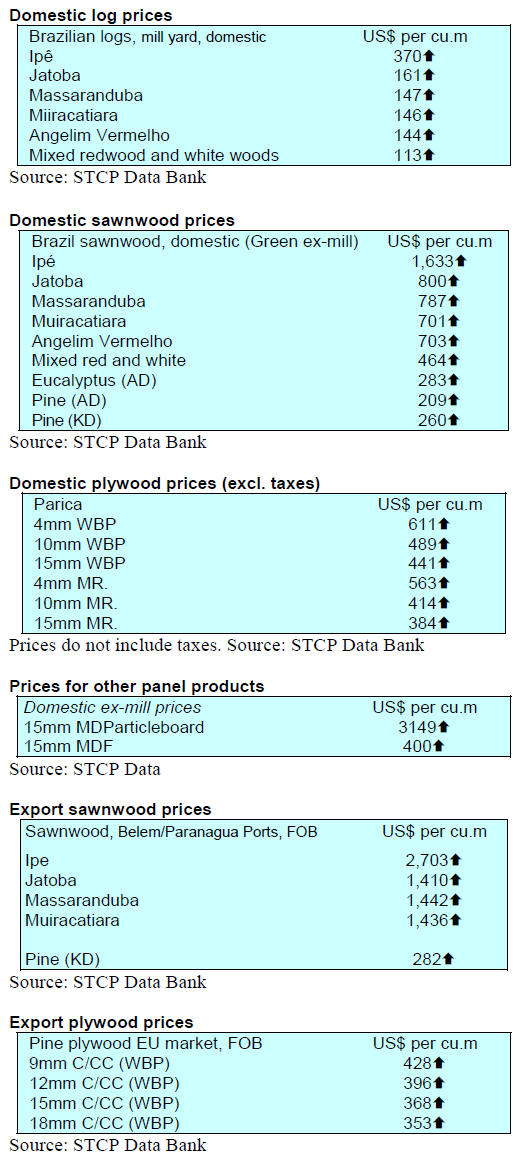

9. PERU
Changes to Forestry and Wildlife Law
raise concerns
The Congress in Peru Republic recently approved
substitute text for Bills 649/2021-CR and 894/2021-CR
which modify the Forestry and Wildlife Law (LFFS) No.
29763. According to the government the objective behind
the change in text is "promotion of development" during
forest zoning processes in different regions of the country.
According to Patricia Torres Muñoz, legal advisor to the
Peruvian Society of Environmental Law (SPDA), the new
provision would legalise a change of unauthorised land
use to land for agricultural purposes and this has raised
concerns as this would bypass the mandatory technical
evaluation that is required for land use change without
evaluation of the impact on the forest and wildlife
heritage.
This change also appears to remove the regulatory
function of the National Forestry and Wildlife Service
(Serfor) in its capacity as the National Forestry and
Wildlife Authority.
See:
https://agraria.pe/noticias/congreso-aprobo-sin-sustentotecnico-propuesta-que-debilitar-28636
and
https://agraria.pe/noticias/serfor-alerta-que-cambio-enclasificacion-de-tierras-y-regla-28672
High fire frequency in some Departments
The National Forest and Wildlife Service (Serfor) has
registered 449 forest fire alerts throughout the country of
which the Departments of Junín (52), Puno (50) and
Ucayali (49) had the highest number.
Serfor’s Functional Satellite Monitoring Unit (UFMS)
forwards fire reports to the Regional Forest and Wildlife
Authorities so that timely action can be taken to combat
the fires.The UFMS also registered a total of 23,283 heat
sources throughout the country. Serfor works with
satellites such as TERRA, AQUA and SUOMI NPP that
provide information on thermal anomalies and has recently
incorporated information from the GOES 16 and GOES 17
satellites for the detection of heat sources with hourly
updates.
See:https://agraria.pe/noticias/congreso-aprobo-sin-sustentotecnico-propuesta-que-debilitar-28636
High fire frequency in Junín, Puno and Ucayali
departments
In related news, Serfor together with the Regional
Governments and the Ministry of Development and Social
Inclusion (Midis), have come together with the aim of
reducing forest fires that affect wild flora and fauna
resources, forests, means of subsistence and the health of
inhabitants.
Serfor, together with 15 GORE, developed training on risk
management in the event of forest fires that included 26
virtual courses. Some 1,630 representatives of district and
provincial municipalities, prefects and sub-prefects,
universities and numerous public institutions participated
in this training.
In related news, in order to provide technical advice and
support the sustainable management of forest resources by
the Regional Government of Ucayali Serfor created a Unit
Functional Liaison (UFE).
Ucayali is the Department with the highest wood
production in the country making it a key region in the
management of forest resources and wildlife. The
functions of the UFEs are to guide, advise and serve the
users of the services provided by the Serfor in forestry and
wildlife matters as well as all the dependencies of the
Forestry Authority in the region.
See:
https://agraria.pe/noticias/congreso-aprobo-sin-sustentotecnico-propuesta-que-debilitar-28636
High fire frequency in Junín, Puno and Ucayali
departments
Peruvian timber exporter in trouble
The Office of the United States Trade Representative has
announced that the Interagency Committee on Trade in
Timber Products from Peru has directed the United States
Customs and Border Protection agency to continue to
block any timber imports from a named Peruvian exporter
as illegally harvested timber has been identified in its
supply chain.
See:
https://www.law360.com/articles/1515575/us-continuesbarring-illegally-harvested-peruvian-timber
and
https://ajot.com/news/ustr-announces-enforcement-action-toblock-illegal-timber-imports-from-peru
